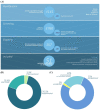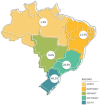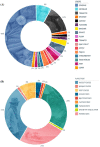Impact of Pesticides on Human Health in the Last Six Years in Brazil
- PMID: 35328887
- PMCID: PMC8951416
- DOI: 10.3390/ijerph19063198
Impact of Pesticides on Human Health in the Last Six Years in Brazil
Abstract
Every year, Brazil intensifies its activity in agriculture and, as a result, it has become one of the biggest consumers of pesticides in the world. The high rate of these substances raises environmental and human health concerns. Therefore, we collected papers from PubMed, Scopus, Scielo, and Web of Science databases, from 2015 to 2021. After a blind selection using the software Rayyan QCRI by two authors, 51 studies were included. Researchers from the South and the Southeast Brazilian regions contributed to most publications, from areas that concentrate agricultural commodity complexes. Among the pesticides described in the studies, insecticides, herbicides, and fungicides were the most frequent. The articles reported multiple toxic effects, particularly in rural workers. The results obtained can be used to direct policies to reduce the use of pesticides, and to protect the health of the population.
Keywords: Brazilian scenario; human health; industrial agriculture; pesticides; rural workers; toxic effects.
Conflict of interest statement
The authors have no conflict of interest to declare.
Figures






Similar articles
-
The Toxic Effects of Glyphosate, Chlorpyrifos, Abamectin, and 2,4-D on Animal Models: A Systematic Review of Brazilian Studies.Integr Environ Assess Manag. 2021 May;17(3):507-520. doi: 10.1002/ieam.4353. Epub 2020 Nov 16. Integr Environ Assess Manag. 2021. PMID: 33006436
-
Agricultural pesticide usage and prioritization in South Korea.J Agromedicine. 2014;19(3):281-93. doi: 10.1080/1059924X.2014.917349. J Agromedicine. 2014. PMID: 24959760
-
Pesticide exposure and depression among agricultural workers in France.Am J Epidemiol. 2013 Oct 1;178(7):1051-8. doi: 10.1093/aje/kwt089. Epub 2013 Jul 12. Am J Epidemiol. 2013. PMID: 23851580
-
Wet deposition of current use pesticides at a rural location on the Delmarva Peninsula: impact of rainfall patterns and agricultural activity.J Agric Food Chem. 2005 Oct 5;53(20):7915-24. doi: 10.1021/jf0507700. J Agric Food Chem. 2005. PMID: 16190650
-
Review: Presence, distribution and current pesticides used in Spanish agricultural practices.Sci Total Environ. 2022 Nov 1;845:157291. doi: 10.1016/j.scitotenv.2022.157291. Epub 2022 Jul 11. Sci Total Environ. 2022. PMID: 35835192 Review.
Cited by
-
Risk assessment of pesticide residues ingestion in food offered by institutional restaurant menus.PLoS One. 2024 Dec 18;19(12):e0313836. doi: 10.1371/journal.pone.0313836. eCollection 2024. PLoS One. 2024. PMID: 39693277 Free PMC article.
-
Environmental impact assessment of tobacco farming in northern Bangladesh.Heliyon. 2023 Mar 11;9(3):e14505. doi: 10.1016/j.heliyon.2023.e14505. eCollection 2023 Mar. Heliyon. 2023. PMID: 36967923 Free PMC article.
-
Pesticide Exposures during Pregnancy and Health Outcomes in Latin America and the Caribbean: A Scoping Review of Human Observational Studies.J Health Pollut. 2024 Aug 15;12(1-4):016001. doi: 10.1289/JHP1043. eCollection 2024 Dec. J Health Pollut. 2024. PMID: 40342952 Free PMC article. Review.
-
New Insights into the Effect of Fipronil on the Soil Bacterial Community.Microorganisms. 2022 Dec 23;11(1):52. doi: 10.3390/microorganisms11010052. Microorganisms. 2022. PMID: 36677344 Free PMC article.
-
The Use of Ozone Technology to Control Microorganism Growth, Enhance Food Safety and Extend Shelf Life: A Promising Food Decontamination Technology.Foods. 2023 Feb 14;12(4):814. doi: 10.3390/foods12040814. Foods. 2023. PMID: 36832889 Free PMC article. Review.
References
-
- Castro N.R., Spolador H.F.S., Marin F.R. Assessing the economy–climate relationships for Brazilian agriculture. Empir. Econ. 2020;59:1161–1188. doi: 10.1007/s00181-019-01711-7. - DOI
-
- de Souza Ramser C.A., Souza A.M., Souza F.M., da Veiga C.P., da Silva W.V. The importance of principal components in studying mineral prices using vector autoregressive models: Evidence from the Brazilian economy. Resour. Policy. 2019;62:9–21. doi: 10.1016/j.resourpol.2019.03.001. - DOI
-
- Brasil, Ministério da Agricultura, P. e A. de D.A Portaria No. 43, de 21 de Fevereiro de 2020. [(accessed on 21 February 2020)]; Available online: http://www.agricultura.gov.br/assuntos/insumos-agropecuarios/insumos-agr....
-
- Centro de Estudos Avançados em Economia Aplicada/Escola Superior de Agricultura “Luiz de Queiroz” PIB do Agronegócio Brasileiro. [(accessed on 27 November 2019)]. Available online: https://www.cepea.esalq.usp.br/br/pib-do-agronegocio-brasileiro.aspx.
-
- Eloy L., Aubertin C., Toni F., Lúcio S.L.B., Bosgiraud M. On the margins of soy farms: Traditional populations and selective environmental policies in the Brazilian Cerrado. J. Peasant Stud. 2016;43:494–516. doi: 10.1080/03066150.2015.1013099. - DOI
Publication types
MeSH terms
Substances
LinkOut - more resources
Full Text Sources
Medical

